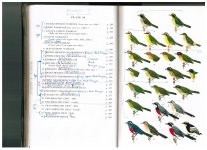I’ve just ordered ATBOTW. It hasn’t arrived yet, but I am looking forward to it. I don’t have the two volume, so this is a step into the unknown. Having read other reviews, I don’t envisage using it as a first stop identification guide, so the index, or lack of, doesn’t really bother me. I simply want to wallow in it and try and avoid getting suffocated by it as I fall asleep in bed.
As for Seabirds, I can’t wait. The first edition was my very first Helm guide and it still holds up well on my bookshelf.












